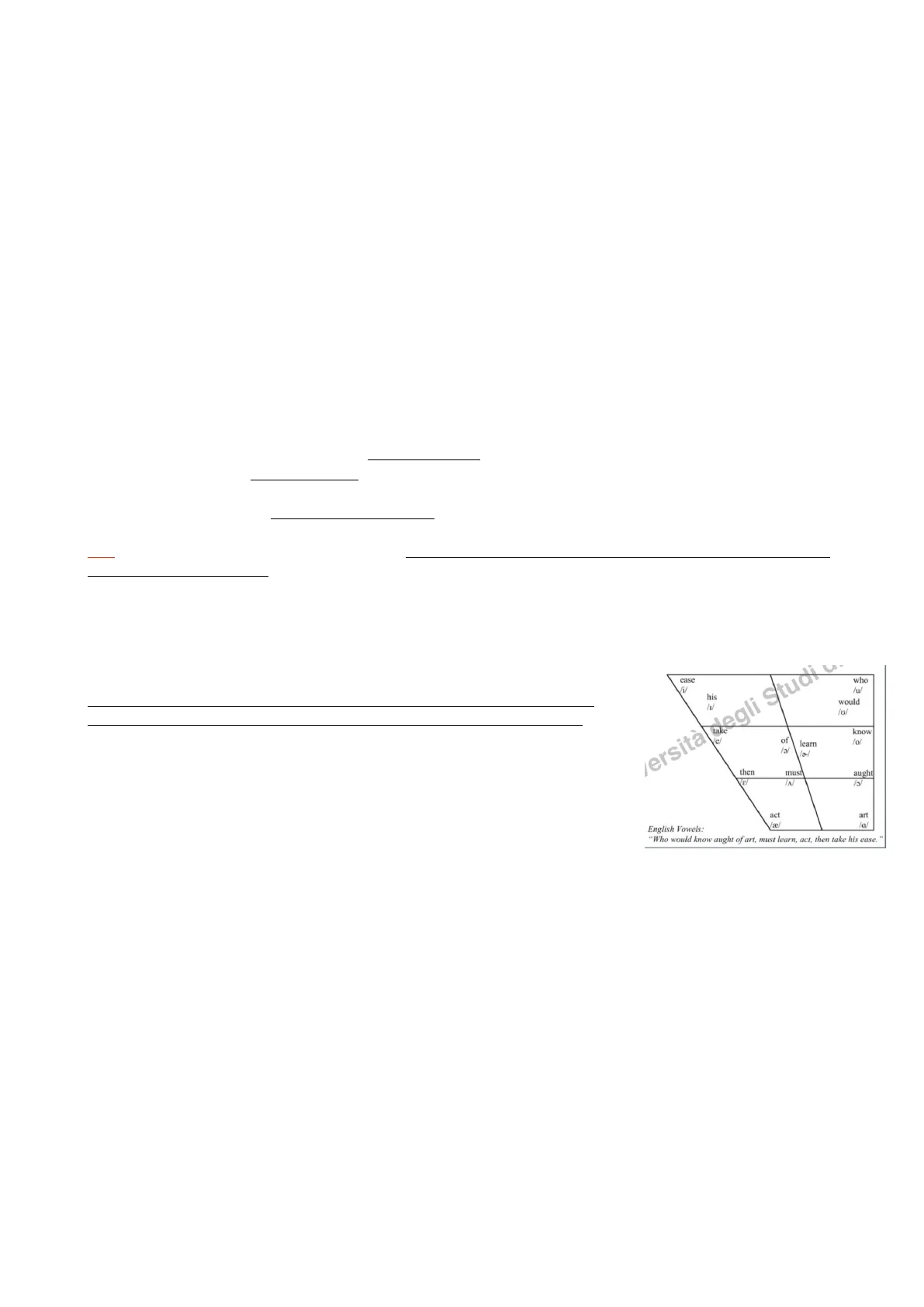Phonetics and Phonology: Understanding English Language Sounds
Document about Phonetics and Phonology. The Pdf explores the concepts of phonetics and phonology, analyzing the production and organization of sounds in the English language. This University-level document, suitable for Languages, covers accents, IPA, assimilation, and stress, providing a comprehensive guide for studying English pronunciation.
See more14 Pages


Unlock the full PDF for free
Sign up to get full access to the document and start transforming it with AI.
Preview
Phonetics and Phonology Overview
PHONETICS -> It is the study of speech and it refers to the physical nature of human speech sounds and to the physical way to producing sounds. We talk about phones. It divides into:
- articulatory phonetics (relates to the speaker)
- acoustic phonetics (relates to the speaker and the hearer)
- auditory phonetics (relates only to the hearer).
PHONOLOGY-> the study of the organisation of sounds in a specific language and of the way in which sounds are combined. We talk about phonemes. English is a stressed-timed language (Italian is a syllable-timed language). The phoneme inventory is a complete set of phonemes in a language / in a particular accent.
Understanding Accent and Pronunciation
An ACCENT (pronunciation) is not a dialect, which includes vocabulary, grammar and spelling. It is a person's distinctive pronunciation which originates in a combination of features, such as your region, social background, educational history, ethnic or religious affiliation and personal aspirations. No two people have exactly the same accent, it is like fingerprints. Naturally, we speak as we learn from our parents (there's not a unique way of speaking, everyone's is different). The accent is born with us: it is acquired from parents and caregivers (when we start speaking we imitate them) -> it depends on where you are from. Accommodation is a psycholinguistic subconscious trait: we spend time together, we sound a little bit like one another. After 11 years old it is more difficult to acquire the accent of a native speaker. In English you can still guess someone's economic or educational background from the voice alone, without even knowing them. This results in:
- Particular accents belong to particular settings
- People accommodate to their surroundings
- People speak more than one English, Londoners are said to have an English for home, an English for friends and another English for work or public domain (Crystal:38)
Prestige: the prestigious accent is the one of the wealthy, upper class (aristocracy, bar and church). Britain: different accents and different dialects; it's official also in other Countries (ex: India); that's why we talk about Englishes in plural.
Received Pronunciation (RP) Accent
RP ACCENT: RECEIVED PRONUNCIATION is a social accent, is regionally non-specific, is not a dialect and is not widely used but it is widely studied and described (3% of the Uk population). It is a young accent and it is a label that was given by the linguist Alexander Ellis in 1869. It was the educated pronunciation of the metropolis (London), the court, the pulpit and the bar (law courts). Daniel Jones, who was a Linguist, adopted Received Pronunciation in 1924, so that we still use it. Received means accepted, approved. Initially, Jones used the term Public School Pronunciation (it was an emerging, socially exclusive accent used by the members of the privileged classes attending boarding schools and the Universities of Oxford and Cambridge, in the south-east of England). It's not really a dialect: the label refers to a specific class associated with a specific region; now, it is no longer associated with a specific region. Natively, only 3% of British people speak like that (while many teach it themselves). In the 20s the BBC was born. They had to choose how to speak in their broadcast, and they chose RP pronunciation in 1922 because if they had chosen a regional accent, maybe people who were not from that region wouldn't accept it; indeed, when they tried to introduce more regional accent, it was not accepted.During WWII, German spies were very good at the RP accent, so the British started broadcasting in regional accents -> it wasn't accepted by viewers. Now, national levels of broadcasting tend to use modern RP, also called BBC English (even though it wasn't their intention to make it the "standard"). As a result, most actors in the theatre and in films adopted an RP pronunciation. With time, this very controlled, clear articulation was associated with the idea of power. This is why villains in American films spoke RP English. As on both sides of the ocean broadcasts were watched in RP, the perception of people was that it was very controlled, clearly articulated, associated with power -> good characters in American movies spoke in American accents, bad characters/villains spoke RP English (unemotional + controlled = power + evil). During the 20th century RP was the voice of education, authority, social status and economic power, so there was a pressure to conform linguistically to the accent of the establishment. Today this is no longer felt necessary -> people feel more free to speak how they want, regional features are not perceived as negatively as they were, there are also more actors with regional accents (Michael Caine).
Types of RP Accents
There are 3 types of RP accents:
- Conservative RP: associated to older speakers or the aristocracy.
- Mainstream RP: neutral accent that can be used regardless of age, occupation or lifestyle of the speaker
- Contemporary RP: younger RP speakers (no regional features)
International Phonemic Alphabet (IPA)
IPA (International Phonemic Alphabet): set of symbols, used to define and describe phonemes/ sounds of all languages. It was devised in the 19th century and it is constantly revised (last revision was in 2015). Some of the symbols are the same as the letters of the alphabet: that's what is confusing about it. Additional symbols had to be inserted to cope with the range of sounds present in the language. In English there are 13 different vowels, of which 2 are diphthongs. We write symbols in // in order to distinguish sounds from letters.
English Vowels Example
ease who his /1/ would /o/ versità know of learn /o/ then must aught IN act art /æ/ /a English Vowels: "Who would know aught of art, must learn, act, then take his ease." Grapheme: letters of the alphabet. Phonemes: distinctive sounds of the language. Silent graphemes: letters that are not pronounced. Homophones: identical pronunciations, but orthographically different (aloud/allowed); Homographs: orthographically identical, but different pronunciations (tear/tear). degli Studiu. /u/
Speech Production Mechanisms
SPEECH PRODUCTION - Respiratory system: to make sounds we need an airflow, that can be egressive or ingressive -> english speech is egressive - Phonatory system: it involves the different positions of the vocal cords/folds in the larynx - Positions of the glottis: it can be closed (no sound), open (voiceless, H), vibrating (voiced sounds), whisper (no vibration) - Articulation: it happens in the vocal tract, in fact to speak we need 1. Pharyngeal cavity 2. Nasal cavity (to breath) 3. Oral cavity (where we produce most of our sounds) The articulators that are active, which means those we can move, are the tongue and lips. Teeth, palate, nose are passive, so we can't move them. For different sounds we use different parts of the tongue: front, tip, back. Lips can change shape: rounded, spread, neutral. When we block the oral cavity, the air can come out of the nasal cavity. Sounds are produced in the vocal tract, which begins in the voice box/larynx and it ends at the lips.
Vocal Tract Organs
· larynx: casting of cartilage rings at the top of the trachea, it has the vocal folds · Vocal cords (space btw them is the glottis) · uvula: piece of flesh which hangs down at the back of the mouth) . Pharynx: tract btw uvula and larynx · Nasal and oral cavity · Palate and velum · Lungs · Oral cavity . Upper lip Vocal Tract (Articulatory Organs) . Lower lip · Upper teeth · Alveolar ridge · Tongue tip · Tongue blade Alveolar Ridge Hard Palus . Tongue body . Tongue root · Epiglottis . Pharynx · Hard palate Larym · Soft palate (velum) Vocal Folds · Larynx [has the vocal folds] Vowel sounds: air comes out of the mouth and there is no constriction. There may be different openings, though. Consonant sounds: airstream has some sort of constriction (closure or stricture) in coming out of the mouth.
Describing Consonant Sounds
DESCRIBING CONSONANTS To describe consonant sounds we use 3 different criteria:
Voicing in Consonants
1. Voicing (presence/absence of voice): voiced vs voiceless sounds. It is caused by the state of the vocal cord in the larynx Closed -> vibration -> voiced Open -> voiceless /h/: aspirate -> produced at the glottis, not in the mouth
Place of Articulation
2. Place of articulation: where the constriction of airflow takes place and it is the art of the vocal tract where the complete or partial closure necessary for a consonant sound is made. Articulators=parts of the mouth involved in making speech sounds Passive articulator - Upper teeth - Alveolar ridge: upper bridge behind the upper row of teeth - Hard palate (roof of the mouth) Active articulator - Lips (tip, blade, front, back and sides) - Soft palate - Velum - Glottis Velam (Soft Palate) Nasal Cavity Nostril- PharymaThey determine the type of sound: bilabial, labio-dental, dental, inter-dental, alveolar, palato- alveolar, palatal, velar, glottal
Manner of Articulation
3. Manner of articulation: how is the airflow constricted and it classifies sounds according to what happens at the airstream as it passes through the vocal tract
Essential Phonology Concepts
ESSENTIAL CONCEPTS AND DEFINITIONS · PHONEMIC TRANSCRIPTION uses the basic sounds of a language, the sounds that are distinctive but not their concrete realisation. It is a broad transcription and it is written in // · PHONETIC TRANSCRIPTION it represents many phonetic details, all the specific sounds, exactly what you hear. It is a narrow transcription and it identifies words written in []
Transcription Examples
PHONEMIC TR. PHONETIC TR. /per/ [pher] pay /ti:/ [thi:] tea /kam [khAm] come
Phonology Branches
· SEGMENTAL PHONOLOGY: how phonemes combine in a language · SUPRASEGMENTAL PHONOLOGY: larger units such as syllables, stress, rhythm and intonation.
Allophones and Variations
. ALLOPHONES: different realisations of the same phoneme in different contexts (see clear /I/ and dark /l/. Cause: influence of adjacent phonemes or the position of the phoneme within a word clear / before a vowel, word initially loop [lu:p] before a vowel, following another consonant plan [plæn] before a vowel, word-medially before /j/ valley [væli] million [miljon] pool [pu:à] dark / word-finally, after a vowel before a consonant shelf, hilltop [feàf], [hlàtop] as a syllable (word-finally) pickle [plkà] Allophonic variations - Aspiration: of the word initial /p,t,k/ at the beginning of a word - when is followed by a short period of glottal friction before the following word begins - Devoicing: when the consonant comes before a pause or before a voiceless consonant (at the end of the word) - Nasalisation: affects the vowel before the nasal
Minimal Pairs
. MINIMAL PAIRS: pairs of words that differ in pronunciation only by one phoneme. For instance kit, cat, cot, caught.
British English Phonemes
British english subset: In English we have 43 phonemes: · 12 vowels (one of which is schwa) -> voiced egressive sounds, no obstruction to airstream . 8 diphthongs -> glides from one vowel sound to another . 24 consonants -> egressive sound accompanied by an obstruction of some kind caused by the movement of one or more articulators